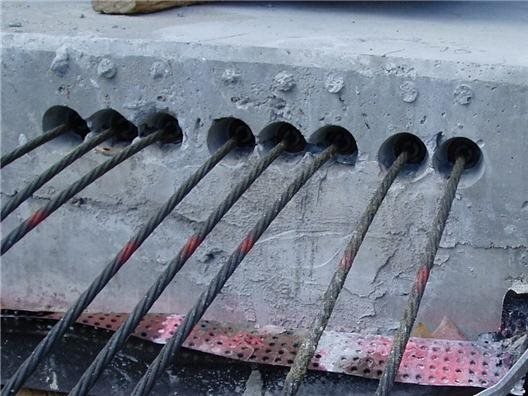Stressing problems (strands sleeping and wire breaking)
A slip of a strand can occur during the stressing process or while anchoring the tendon. The slip of a strand can occur due to rusted wedges and rusted wedge plate holes. The rust or dirt will prevent the wedges from firmly gripping the strands. Worn teeth of jack wedge can be another reason for strand slipping. Strands slippage can be prevented by using of well-maintained wedges, wedge plates, and jacks.
Slippage of strands will be discovered from the marks made on strands tail for this purpose. If the slip is significant (more than 1 in (25mm)), the effects of strand slip should be considered. Slipped strand will have lower stress than other strands. This will reduce the overall force of the tendon. In order not to overstress other strands, the prestressing force should be reduced proportionally to account for the strand slip. For example, if one strand out of ten slip, then the pressure gauge should be reduced by one to ten while the tendon is stressed to the originally required elongation. Let assume there is 12 tendon and the target elongation is 6 in (152mm). One strand slip by 2 (50mm) in and another strand slip by 3 in (75 mm). in this case, the pressure will be reduced by (2+3)/(6*12).
Figure 1
The slipped strands should be stressed after stressing the rest of the strands. The stressing of slipped strands is important to attain the required prestressing force. Stressing of these strands can be performed individually by the using of mono-jacks. However, strands should be treated with care because there is a possibility that some slipped strands are trapped.
Wire break is another stressing problem that may occur during the stressing procedure. If one or two-wire breaks, it may cause minimal effects. If one wire breaks, 1/7 of the strand capacity is lost. For tendons with many strands, the breaking of one or two-wire will not cause a major problem. We can recognize the wires break from the sharp popping noise. When an excessive number of wires breaks, the strands with damaged wires or the whole tendons should be replaced.
The wires break due to overstressing, bad wedges, high friction points in the duct. Careful examination and revising the prestressing calculation will determine the reason behind wires breaking. Persistent wire breakage should be investigated and action is taken to change procedures or equipment to avoid or significantly lessen the problem.
















Comments
Post a Comment